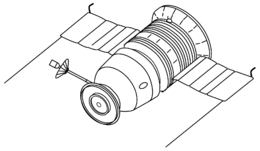Zond 1
|
The Russian Zond 1 | |||||
| COSPAR ID | 1964-016D | ||||
|---|---|---|---|---|---|
| SATCAT № | 00785 | ||||
| Spacecraft properties | |||||
| Bus | 3MV-1 | ||||
| Launch mass | 890 kilograms (1,960 lb) | ||||
| Dimensions |
3.6 m (12 ft) tall 1.1 m (3 ft 7 in) diameter | ||||
| Start of mission | |||||
| Launch date | 02:42:40, April 2, 1964 | ||||
| Rocket | modified SS-6 Sapwood | ||||
| Launch site | Tyuratam | ||||
| End of mission | |||||
| Last contact | May 24, 1964 | ||||
| Flyby of Venus | |||||
| Closest approach | 1964-07-19 | ||||
| Distance | 100,000 km (62,000 mi) | ||||
| |||||
Zond 1 was a member of the Soviet Zond program. It was the second Soviet research spacecraft to reach Venus, although communications had failed by that time. It carried a 90 cm spherical landing capsule, containing experiments for chemical analysis of the atmosphere, gamma-ray measurements of surface rocks, a photometer, temperature and pressure gauges, and a motion/rocking sensor in case it landed in water.
History
At least three previous Soviet planetary probes had been lost due to malfunctions of the ullage rockets (BOZ) on the Blok L stage, but an investigation found that the problem was easily resolved. The spacecraft, a Venera 3MV-1, was launched on April 2, 1964 from Tyuratam and this time the launch vehicle performed flawlessly. During the cruise phase, a slow leak from a cracked sensor window caused the electronics compartment to lose air pressure. This was a serious problem as Soviet electronics relied on vacuum tubes which would overheat without cooling air. An ill-timed command from ground control turned on its radio system while there was still a rarefied atmosphere inside, causing the electronics to short out by corona discharge. Since the mission could not succeed, it was unacceptable to give it a Venera designation, but as the probe had exited Earth orbit, it also could not be given the Kosmos cover name, so Soviet authorities instead announced the probe as "Zond" and claimed that it was designed to "stress-test components in deep space". Chief Designer Sergei Korolev was upset at the failure of the mission and demanded higher quality control from the OKB-1 Bureau, including X-rays to test for pressure leaks.
By mid-April, the electronics in the main spacecraft had completely failed and all signal transmission ceased, however communication via the lander could still be performed and space radiation and atomic-hydrogen spectrometer measurements were received. The star trackers in the spacecraft were also used to align it for a course-correction burn, but the second one was off by 65 feet per second (20 meters per second). Also one of the star trackers failed, forcing ground controllers to place Zond 1 into a spin-stabilization mode. However, all communications had failed by May 14. It passed 100,000 km from Venus on July 14, 1964.
See also
External links
| Preceded by None |
Zond program (interplanetary) | Succeeded by Zond 2 |




